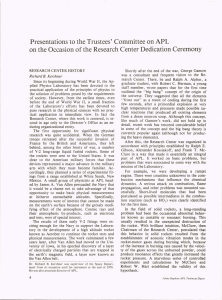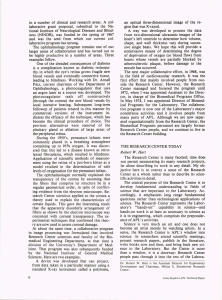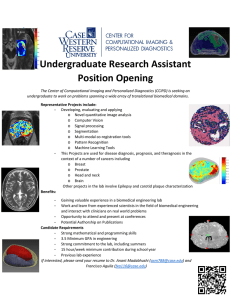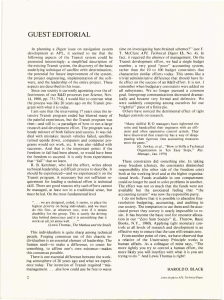Up to that point, most ... ones made to date. We ...
advertisement
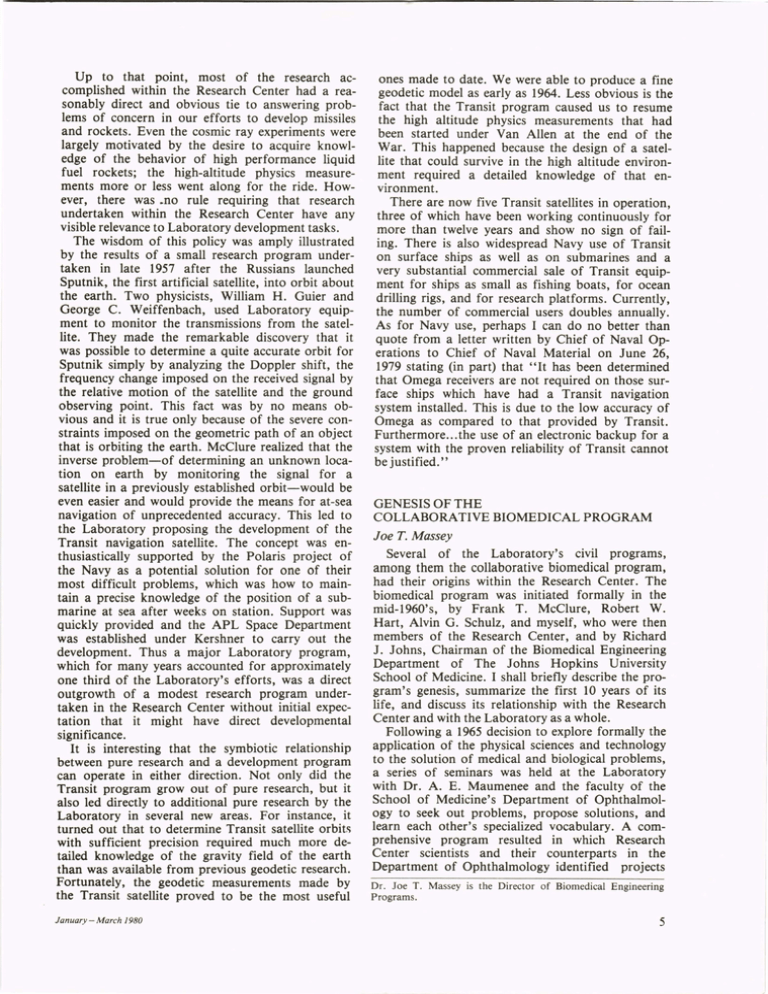
Up to that point, most of the research accomplished within the Research Center had a reasonably direct and obvious tie to answering problems of concern in our efforts to develop missiles and rockets. Even the cosmic ray experiments were largely motivated by the desire to acquire knowledge of the behavior of high performance liquid fuel rockets; the high-altitude physics measurements more or less went along for the ride. However, there was .. no rule requiring that research undertaken within the Research Center have any visible relevance to Laboratory development tasks. The wisdom of this policy was amply illustrated by the results of a small research program undertaken in late 1957 after the Russians launched Sputnik, the first artificial satellite, into orbit about the earth. Two physicists, William H. Guier and George C. Weiffenbach, used Laboratory equipment to monitor the transmissions from the satellite. They made the remarkable discovery that it was possible to determine a quite accurate orbit for Sputnik simply by analyzing the Doppler shift, the frequency change imposed on the received signal by the relative motion of the satellite and the ground observing point. This fact was by no means obvious and it is true only because of the severe constraints imposed on the geometric path of an object that is orbiting the earth. McClure realized that the inverse problem-of determining an unknown location on earth by monitoring the signal for a satellite in a previously established orbit-would be even easier and would provide the means for at-sea navigation of unprecedented accuracy. This led to the Laboratory proposing the development of the Transit navigation satellite. The concept was enthusiastically supported by the Polaris project of the Navy as a potential solution for one of their most difficult problems, which was how to maintain a precise knowledge of the position of a submarine at sea after weeks on station. Support was quickly provided and the APL Space Department was established under Kershner to carry out the development. Thus a major Laboratory program, which for many years accounted for approximately one third of the Laboratory's efforts, was a direct outgrowth of a modest research program undertaken in the Research Center without initial expectation that it might have direct developmental significance. It is interesting that the symbiotic relationship between pure research and a development program can operate in either direction. Not only did the Transit program grow out of pure research, but it also led directly to additional pure research by the Laboratory in several new areas. For instance, it turned out that to determine Transit satellite orbits with sufficient precision required much more detailed knowledge of the gravity field of the earth than was available from previous geodetic research. Fortunately, the geodetic measurements made by the Transit satellite proved to be the most useful January-March 1980 ones made to date. We were able to produce a fine geodetic model as early as 1964. Less obvious is the fact that the Transit program caused us to resume the high altitude physics measurements that had been started under Van Allen at the end of the War. This happened because the design of a satellite that could survive in the high altitude environment required a detailed knowledge of that environment. There are now five Transit satellites in operation, three of which have been working continuously for more than twelve years and show no sign of failing. There is also widespread Navy use of Transit on surface ships as well as on submarines and a very substantial commercial sale of Transit equipment for ships as small as fishing boats, for ocean drilling rigs, and for research platforms. Currently, the number of commercial users doubles annually. As for Navy use, perhaps I can do no better than quote from a letter written by Chief of Naval Operations to Chief of Naval Material on June 26, 1979 stating (in part) that "It has been determined that Omega receivers are not required on those surface ships which have had a Transit navigation system installed. This is due to the low accuracy of Omega as compared to that provided by Transit. Furthermore ... the use of an electronic backup for a system with the proven reliability of Transit cannot be justified." GENESIS OF THE COLLABORATIVE BIOMEDICAL PROGRAM Joe T. Massey Several of the Laboratory's civil programs, among them the collaborative biomedical program, had their origins within the Research Center. The biomedical program was initiated formally in the mid-1960's, by Frank T. McClure, Robert W. Hart, Alvin G. Schulz, and myself, who were then members of the Research Center, and by Richard J. Johns, Chairman of the Biomedical Engineering Department of The Johns Hopkins University School of Medicine. I shall briefly describe the program's genesis, summarize the first 10 years of its life, and discuss its relationship with the Research Center and with the Laboratory as a whole. Following a 1965 decision to explore formally the application of the physical sciences and technology to the solution of medical and biological problems, a series of seminars was held at the Laboratory with Dr. A. E. Maumenee and the faculty of the School of Medicine's Department of Ophthalmology to seek out problems, propose solutions, and learn each other's specialized vocabulary. A comprehensive program resulted in which Research Center scientists and their counterparts in the Department of Ophthalmology identified projects Dr. Joe T. Massey is the Director of Biomedical Engineering Programs. 5 in a number of clinical and research areas. A collaborative grant proposal, submitted to the National Institute of Neurological Diseases and Blindness (NINDB), was funded in the spring of 1967 and was the seed from which our current collaborative program has sprung. The ophthalmology program remains one of our larger areas of collaboration and has turned out to be highly productive in a number of areas. Three examples follow. One of the dreaded consequences of diabetes is a complication known as diabetic retinopathy in which the eye's retina grows fragile new blood vessels and eventually connective tissue, leading to blindness. Working with Dr. Arnall Patz, current chairman of the Department of Ophthalmology, a photocoagulator that uses an argon laser as a source was developed. The photocoagulator seals off noninvasively (through the cornea) the new blood vessels by local intensive heating. Subsequent long-term followup of patients treated in this manner by commercial versions of the instrument indicates the efficacy of the technique, which has become the clinical procedure of choice. The previous alternatives were removal of the pituitary gland or ablation of large areas of the peripheral retina. During the 1950's, premature infants were commonly placed in a breathing atmosphere containing up to 95070 oxygen. It was discovered that this led to a disease known as retrolental fibroplasia, which resulted in blindness. Application of scientific methods of measurement using the retina of a just-born kitten as a model resulted in the determination of safe levels of oxygenation for the premature infant. The ophthalmologist normally explained the transparency of the cornea by assuming that the fibers that comprise its structure lie in a regular geometrical order, in spite of conflicting evidence from the electron microscope. Research Center scientists applied to the cornea a theory used to explain the characteristics of certain liquids. This gave the interesting result that the apparently disorderly arrangement of fibers as shown by the electron microscope was consistent with corneal transparency. The experimental techniques that confirmed this theory are now used to assess corneal damage. At about the same time, a collaborative program in image processing was formulated that involved Research Center scientists and faculty of the Biomedical Engineering Department, at that time a division of the University's Department of Medicine. That program was also subsequently funded by the National Institute of General Medical Sciences. Here are two examples. A device was developed that can project, from data taken in a particular manner using a standard X-ray instrument called a polytome, 6 an optical three-dimensional image of the region that was X-rayed. A way was developed to process the data from two-dimensional ultrasonic images of the heart's left ventricle to determine how volume, shape, and wall thickness vary during successive single beats. We hope this will provide a noninvasive means of determining the degree of deprivation of oxygen (or blood flow) from hearts whose vessels are partially blocked by atherosclerotic plaque, before damage to the muscle has occurred. The next major collaborative effort, in 1968, was in the field of cardiovascular research. It was the first effort that mainly involved people from outside the Research Center. However, the Research Center managed and fostered the program until 1972, when I was appointed Assistant to the Director, in charge of the Biomedical Programs Office. In May 1974, I was appointed Director of Biomedical Programs for the Laboratory. The collaborative program is now one of the Laboratory's major nondefense activities and it involves people from many parts of APL. Although we are now separated organizationally from the Research Center, the Biomedical Programs personnel are largely former Research Center people, and we continue to live in the Research Center building. THE RESEARCH CENTER TODAY Robert W. Hart The Research Center is many faceted; time does not permit enumerating its many research projects, let alone describing its work in any detail. My objective here is to convey a sense of the Research Center as a whole rather than to describe its scientific activities in detail. The central purpose of the Research Center is to develop fundamental understanding in fields of science that are important to the Laboratory. Accordingly, it emphasizes long range fundamental questions rather than technological applications of science. The Research Center represents the Laboratory's "hands-on" capability in science-and hands-on work is at least as necessary in science as it is in engineering, which comprises the preponderance of APL's activities. Science is very much an art and one does not become an artist merely by watching artists. In a sense, the Research Center is APL's window into science: its researchers attend scientific meetings, present research papers, publish in the literature, write books now and then, and bring back new science to the Laboratory. But the Center is more than a window, it is a doorway: Research Center people pass through it into the rest of the LaboraDr. Robert W. Hart is the Assistant Director for Exploratory Development and Chairman, Milton S. Eisenhower Research Center. Johns Hopkins A PL Technical Digest
